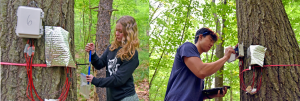Earth systems models are an important tool for studying complex processes occurring around the planet, such as those in and between the atmosphere and biosphere, and they help researchers and policymakers better understand phenomena like climate change. Incorporating more data into these simulations can improve modeling accuracy; however, sometimes, this requires the arduous task of gathering millions of data points.
Researchers, including UConn Department of Natural Resources and the Environment Assistant Professor James Knighton, Pablo Sanchez-Martinez from the University of Edinburgh, and Leander Anderegg from the University of California Santa Barbara, have developed a method to bypass the need for gathering data for over 55,000 tree species to better account for how plants influence the flow of water around the planet. Their findings are published in Nature Scientific Data.
Plants play essential roles in Earth’s processes, from capturing carbon and making oxygen available for other life forms like humans. Plants are also responsible for the movement of water, says Knighton, where an estimated 60% of all rain is returned to the atmosphere through transpiration. This huge global-scale movement of water through plants is complex and currently represented by Earth system models (ESMs) in a simplified way says Knighton, where all plants in a region may be considered as a single entity (i.e., a plant functional type),
“Plant Functional Types (PFTs) are used because we don’t know a lot about the details of individual plant species,” says Knighton, a faculty member in the College of Agriculture, Health and Natural Sciences. “It would be harder to take a detailed map of vegetation over a continent and put in all the right values for each individual species so it’s easier just to consider one generic PFT.”
The problem with PFTs is that different plant species vary in their hydrologic traits – or how water moves through plants — and this oversimplification of such systemically influential traits could limit the effectiveness of available models to predict the future. Scientists have moved towards accounting for these differences by creating databases, like the TRY Plant Trait Database, where this information is collected. However, Knighton points out that only about 5,000 to 15,000 plant species have had their traits well-cataloged after several centuries of plant science.
“There are around 60,000 to 70,000 tree species on Earth, meaning that after 200 years, we know maybe 5 to 10% of what’s happening,” he says. “If that were the way we would do things, it would take us another 2,000 years or so to learn about all the plants that we needed to, and at that point, climate change has set in, and it’s too late. We can’t do that. We can’t just wait for field researchers to go out and do their studies and populate this global database. It’s still incredibly useful to conduct field studies, but those alone will not get us where we need to be fast enough.”
Knighton and his colleagues decided to address this problem and expedite the process by looking at the data for traits that are available, information like how tall a tree grows, how deep the roots descend, or how fast water flows within the plant. They then compared the history of that species and its relatedness to other species in what is called a phylogenetic test for those traits.
“We looked to see how similar trait values are between closely related species, and the idea behind that is, if these traits are critical for their survival, evolution will have preserved the trait values, they won’t be randomly dispersed,” Knighton says. “For example, if growing deep roots was critical for a certain type of plant to survive, the species that branch off from that one will probably also have deep roots, and everything that’s in that family or that genus will have a similar root structure.”

The researchers performed the test for all the traits, and Knighton says they found high levels of conservation across the phylogenetic tree, which means closely related species tend to have closer trait values.
“Then we took the phylogeny where you can take all of the plant species on Earth and map them onto each other, and show exactly how closely related each plant is to every other plant,” he says.
Knighton says they can impute the trait data if they have the information for closely related species, meaning that this data can be inferred without having to take millions of field measurements.
“We used different numerical machine learning techniques, and in doing that, we were able to come up with a database of these very critical tree values for 55,000 tree species on Earth,” he says. “If you want to do global modeling that includes more detail in the vegetation, which is important, you now have a starting point. You don’t have to use this generic, one plant species per continent approach, you could, in theory, try something more detailed, but putting in all the different species and seeing what happens.”
Knighton says they consider this work to be a low-order approximation, but it is an important starting point. As more data is collected from field researchers, the data can be used to update and refine the interpolated data to improve the accuracy of this approach.
This work is the next step in a larger project, the first step of which was a proof-of-concept experiment at a smaller, more local level. That project established this method of imputing hydrologic traits as a viable approach, and Knighton says the next step is to compare the imputed data with observational data that they are collecting in UConn Forest and from other sites around the United States.
Knighton explains there are 10 sites across the U.S. where ample data is collected, which will serve as test cases. Knighton says master’s student Caroline Stanton ’26 is currently building ecosystem models of each site, and they are calibrating high-resolution models to estimate the traits which they will compare with data that scientists have collected over the last 20 years. Then, they will compare the estimated plant trait results with the observational data collected from the site to see how the quality of the model is impacted by each approach.
Eventually, the researchers hope to apply the method to forested sites across the globe to study aspects of what drives traits to vary. Understanding the variation in traits across different plant species has the potential to strengthen the accuracy of models, but these data can also give insights into what drives the different traits to vary.
Knighton says he and his colleagues hope climate modelers will find this information helpful, but they also hope it can improve our understanding of the Earth system overall, and more about the vital roles plants play,
“Plants control our environment to an incredible degree.”
This work is supported by the National Science Foundation (Grant numbers 2243263, 2003205, 20230833 and 2216855), Renewable Energy, Natural Resources, and Environment: Agroecosystem Management (GRANT13398847 from the USDA National Institute of Food and Agriculture.)



